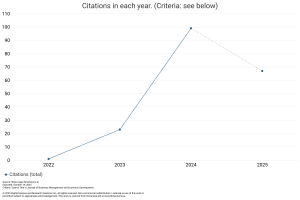Study of Gender and Economic Growth in South Kalimantan
DOI:
https://doi.org/10.59653/jbmed.v1i02.133Keywords:
Gender Inequality, Growth Economic, Life Expectancy, Mean Years of Schooling, Labor Farce ParticipationAbstract
This study aims to analyze how gender inequality affects economic growth. The components used are Life Expectancy, Mean Years of Schooling, and Labor Force Participation Rate, while Economic Growth is through the value of Gross Regional Domestic Product. The analysis technique used is panel data regression analysis using a random effect model. The results of this study are first, gender inequality seen from the component of life expectancy partially has a positive and insignificant effect on economic growth in South Kalimantan Province, the mean years of schooling and the labor force participation rate partially have a negative and significant effect on economic growth in South Kalimantan Province in 2011-2021. Second, gender inequality is seen through the components of life expectancy, the mean years of schooling and the participation rate of the workforce simultaneously influencing economic growth in South Kalimantan Province in 2011-2021.
Downloads
References
Aktaria, E., & Handoko, B. S. (2012). Ketimpangan Gender Dalam Pertumbuhan Ekonomi. Jurnal Ekonomi Pembangunan: Kajian Masalah Ekonomi Dan Pembangunan, 13(2), 194. https://doi.org/10.23917/jep.v13i2.168
Aliyah, A. (2023). SETARA: Jurnal Studi Gender dan Anak. E-Journal.Metrouniv.Ac.Id, 4(2). https://e-journal.metrouniv.ac.id/index.php/jsga/article/view/5463%0Ahttps://e-journal.metrouniv.ac.id/index.php/jsga/article/download/5463/3146
Gorman, B. K., & Read, J. G. (2007). Why Man Die Younger Than Woman. http://www.medscape.com/viewartic%0Ale/555221_2.
Handayani, N. S., Bendesa, I. K. ., & Yuliarni, N. N. (2016). Pengaruh Jumlah Penduduk, Angka Harapan Hidup, Rata-rata lama sekolah dan PDRB Per Kapita terhadap Pertumbuhan Ekonomi di Provinsi Bali. E-Jurnal Ekonomi Dan Bisnis Universitas Udayana, 5(10), 3449–3474.
Khotimah, K. (2009). Diskriminasi Gender Terhadap Perempuan Dalam Sektor Pekerjaan. Studi Gender & Anak, 4(1), 158–180.
Kim, J., Lee, J., & Shin, K. (2016). A Model of Gender Inequality and Economic Growth. 475.
Klasen, S., & Lamanna, f. (2008). The Impact of Gender Inequality in Education and Employment on Economic Growth in Developing Countries: Updates and Extensions. Feminist Economics, Vol. 15.
Muda, R., Koleangan, R., & Kalangi, J. B. (2019). Pengaruh angka harapan hidup, tingkat pendidikan dan pengeluaran perkapita terhadap pertumbuhan ekonomi di sulawesi utara pada tahun 2003-2017. Jurnal Berkala Ilmiah Efisiensi, 19(01), 44–55.
Padang, D. M., Anis, A., & Ariusni. (2019). Analisis Pengaruh Kesetaraan Gender Terhadap Pertumbuhan Ekonomi di Sumatera Barat. Jurnal Kajian Ekonomi Dan Pembangunan , 1(3), 969–976.
Pritchett, L. (2001). Where has all the education gone? World Bank Economic Review, 15(3), 367–391. https://doi.org/10.1093/wber/15.3.367
Priyadi, U., & Astuti, B. (2003). Tingkat Kesetaraan Gender Pada Industri Kulit di Provinsi Daerah Istimewa Yogyakarta. Economic Journal of Emerging Markets, Vo. 8 No.
Puspasari, S. (2019). Pengaruh Partisipasi Angkatan Kerja Terdidik Terhadap Pertumbuhan Ekonomi di Indonesia: Perspektif Modal Manusia. Jurnal Ilmu Administrasi (JIA), XVI(2), 194–209.
Rahmawati, F., & Hidayah, Z. M. (2020). Menelusur Relasi Indeks Pembangunan Gender Terhadap Pertumbuhan Ekonomi. EcceS (Economics, Social, and Development Studies), 7(1), 110. https://doi.org/10.24252/ecc.v7i1.13919
Ripandi, A. (2019). Pengaruh Ipm, Dana Desa Dan Infrastruktur Terhadap Pertumbuhan Ekonomi Di 13 Kabupaten/Kota Di Kalimantan Selatan. JIEP: Jurnal Ilmu Ekonomi Dan Pembangunan, 1(1), 133–144. https://doi.org/10.20527/jiep.v1i1.1122
Sadano, S. (2000). Makroekonomi Modern: Perekembangan Pemikiran Dari Klasik Hingga Keynesian Baru. Raja Grafindo Pustaka.
Sari, N., & Yunani, A. (2020). Pengaruh Pendapatan Perkapita, Indeks Pembangunan Manusia dan Pertumbuhan Ekonomi Terhadap Jumlah Penduduk Di Kota Banjarmasin. JIEP: Jurnal Ilmu Ekonomi Dan Pembangunan, 3(1). https://doi.org/10.20527/jiep.v3i1.2222
Seguino, S. (2000). Gender inequality and economic growth: A cross-country analysis. World Development, 28(7), 1211–1230. https://doi.org/10.1016/S0305-750X(00)00018-8
Suryadi, A. E. (2004). Kesetaraan Gender dalam Bidang Pendidikan. PT. Ganesindo.
Todaro, M.P., & Smith, S. C. (2006). Pembangunan Ekonomi . (Edisi Kese). Erlangga.
Yahya, D., & Wardhana, A. (2022). Analisis Pertumbuhan Ekonomi Dan Pengembangan Sektor Potensial di Kota Banjarmasin Tahun 2013 s.d 2017. JIEP: Jurnal Ilmu Ekonomi Dan Pembangunan, 5(1). https://doi.org/10.20527/jiep.v5i1.5521
Downloads
Published
How to Cite
Issue
Section
License
Copyright (c) 2023 Maulidina Ar'rida, Yunita Sopiana

This work is licensed under a Creative Commons Attribution-ShareAlike 4.0 International License.
Authors who publish with this journal agree to the following terms:
- Authors retain copyright and grant the journal right of first publication with the work simultaneously licensed under a Creative Commons Attribution-ShareAlike that allows others to share the work with an acknowledgement of the work's authorship and initial publication in this journal.
- Authors are able to enter into separate, additional contractual arrangements for the non-exclusive distribution of the journal's published version of the work (e.g., post it to an institutional repository or publish it in a book), with an acknowledgement of its initial publication in this journal.
- Authors are permitted and encouraged to post their work online (e.g., in institutional repositories or on their website) prior to and during the submission process, as it can lead to productive exchanges, as well as earlier and greater citation of published work (See The Effect of Open Access).





























